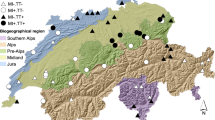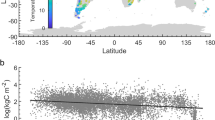Abstract
The world’s soils store more carbon than is present in biomass and in the atmosphere1. Little is known, however, about the factors controlling the stability of soil organic carbon stocks2,3,4 and the response of the soil carbon pool to climate change remains uncertain5,6. We investigated the stability of carbon in deep soil layers in one soil profile by combining physical and chemical characterization of organic carbon, soil incubations and radiocarbon dating. Here we show that the supply of fresh plant-derived carbon to the subsoil (0.6–0.8 m depth) stimulated the microbial mineralization of 2,567 ± 226-year-old carbon. Our results support the previously suggested idea7 that in the absence of fresh organic carbon, an essential source of energy for soil microbes, the stability of organic carbon in deep soil layers is maintained. We propose that a lack of supply of fresh carbon may prevent the decomposition of the organic carbon pool in deep soil layers in response to future changes in temperature. Any change in land use and agricultural practice that increases the distribution of fresh carbon along the soil profile1,8,9 could however stimulate the loss of ancient buried carbon.
This is a preview of subscription content, access via your institution
Access options
Subscribe to this journal
Receive 51 print issues and online access
$199.00 per year
only $3.90 per issue
Buy this article
- Purchase on Springer Link
- Instant access to full article PDF
Prices may be subject to local taxes which are calculated during checkout


Similar content being viewed by others
References
Jobbágy, E. G. & Jackson, R. B. The vertical distribution of soil organic carbon and its relation to climate and vegetation. Ecol. Appl. 10, 423–436 (2000)
Martel, Y. A. & Paul, E. A. The use of radiocarbon dating of organic matter in the study of soil genesis. Soil Sci. Soc. Am. Proc. 38, 501–506 (1974)
Rumpel, C., Kögel-Knabner, I. & Bruhn, F. Vertical distribution, age, and chemical composition of organic carbon in two forest soils of different pedogenesis. Org. Geochem. 33, 1131–1142 (2002)
Schöning, I. & Kögel-Knabner, I. Chemical composition of young and old carbon pools throughout Cambisol and Luvisol profiles under forests. Soil Biol. Biochem. 38, 2411–2424 (2006)
Luo, Y., Wan, S., Hui, D. & Wallace, L. L. Acclimatization of soil respiration to warming in a tall grass prairie. Nature 413, 622–624 (2001)
Bellamy, P. H., Loveland, P. J., Bradley, R. I., Lark, R. M. & Kirk, G. J. D. Carbon losses from all soils across England and Wales 1978–2003. Nature 437, 245–247 (2005)
Fontaine, S. & Barot, S. Size and functional diversity of microbe populations control plant persistence and long-term soil carbon accumulation. Ecol. Lett. 7, 1075–1087 (2005)
Hurd, E. A. Phenotype and drought tolerance in wheat. Agric. Meteorol. 14, 39–55 (1974)
Lal, R. Soil carbon sequestration impacts on global climate change and food security. Science 304, 1623–1627 (2004)
Boivin, P. et al. Volcanologie de la Chaîne des Puys (Parc naturel régional de la chaîne des Puys, Clermont Ferrand, 2004)
FAO-Unesco Soil Map of the World (1:5,5000 000) (Unesco, Paris, 1974)
Jenkinson, D. S., Harkness, D. D., Vance, E. D., Adams, D. E. & Harrison, A. F. Calculating net primary production and annual input of organic matter to soil from the amount and radiocarbon content of soil organic matter. Soil Biol. Biochem. 24, 295–308 (1992)
Kögel-Knabner, I. 13C and 15N NMR spectroscopy as a tool in soil organic matter studies. Geoderma 80, 243–270 (1997)
Baldock, J. A. & Skjemstad, J. O. Role of the matrix and minerals in protecting natural organic materials against biological attack. Org. Geochem. 31, 697–710 (2000)
Wattel-Koekkoek, E. J. W., Buurman, P., van der Plicht, J., Wattel, E. & van Breemen, N. Mean residence time of soil organic matter associated with kaolinite and smectite. Eur. J. Soil Sci. 54, 269–278 (2003)
Kuzyakov, Y., Friedel, J. K. & Stahr, K. Review of mechanisms and quantification of priming effects. Soil Biol. Biochem. 32, 1485–1498 (2000)
Cheng, W., Johnson, D. W. & Fu, S. Rhizosphere effects on decomposition: Controls of plant species, phenology, and fertilisation. Soil Sci. Soc. Am. J. 67, 1418–1427 (2003)
Fontaine, S., Bardoux, G., Abbadie, L. & Mariotti, A. Carbon input to soil may decrease soil carbon content. Ecol. Lett. 7, 314–320 (2004)
Malosso, E., English, L., Hopkins, D. W. & O'Donnell, A. G. Use of 13C-labelled plant materials and ergosterol, PLFA and NLFA analyses to investigate organic matter decomposition in Antarctic soil. Soil Biol. Biochem. 36, 165–175 (2003)
Carney, K. M., Hungate, B. A., Drake, B. G. & Megonigal, J. P. Altered soil microbial community at elevated CO2 leads to loss of soil carbon. Proc. Natl Acad. Sci. USA 104, 4990–4995 (2007)
Ciais, P. et al. Europe-wide reduction in primary productivity caused by the heat and drought in 2003. Nature 437, 529–533 (2005)
Davidson, E. A. & Janssens, I. A. Temperature sensitivity of soil carbon decomposition and feedbacks to climate change. Nature 440, 165–173 (2006)
Loiseau, P. & Soussana, J. F. Elevated [CO2], temperature increase and N supply effects on the turnover of below-ground carbon in a temperate grassland ecosystem. Plant Soil 210, 233–247 (1999)
Vance, E. D., Brookes, P. C. & Jenkinson, D. S. An extraction method for measuring soil microbial biomass C. Soil Biol. Biochem. 19, 703–707 (1987)
Hsieh, Y.-P. Radiocarbon signatures of turnover rates in active soil organic carbon pools. Soil Sci. Soc. Am. J. 57, 1020–1022 (1993)
Eusterhues, K., Rumpel, C., Kleber, M. & Kögel-Knabner, I. Stabilisation of soil organic matter by interactions with minerals as revealed by mineral dissolution and oxidative degradation. Org. Geochem. 34, 591–1600 (2003)
Mehra, O. P. & Jackson, M. L. Iron oxide removal from soils and clays by dithionite-citrate system buffered with sodium bicarbonate. Clays Clay Miner. 32, 557–563 (1960)
Klumpp, K., Soussana, J. F. & Falcimagne, R. Effects of past and current disturbance on carbon cycling in grassland mesocosms. Agric. Ecosyst. Environ. 121, 59–73 (2007)
Schmidt, M. W. I., Knicker, H., Hatcher, P. G. & Kögel-Knabner, I. Improvement of 13C and 15N CPMAS NMR spectra of bulk soils, particle size fractions and organic material by treatment with hydrofluoric acid (10%). Eur. J. Soil Sci. 48, 319–328 (1997)
Stuiver, M. & Polach, H. A. Discussion—reporting of 14C data. Radiocarbon 19, 355–363 (1977)
Acknowledgements
We thank S. Révaillot, J. Messaoud, S. Millon, G. Alavoine and O. Delfosse for assistance during the incubation and for chemical and isotopic analysis. We thank J.-F. Soussana, J. Bloor, R. Hakkenberg, P. Loiseau, V. Maire, A. Chabbi and K. Klumpp for critical comments on the manuscript. The Lehrstuhl für Bodenkunde, TU München, is acknowledged for providing the NMR spectrometer. The Hydrasa Laboratory (University of Poitiers) is acknowledged for providing the X-ray diffractometer. This work was financially supported by the INRA Ecology Department, the MED (GESSOL) and the ANR (BIOMOS and C Profond).
Author Contributions S.F. conceived and designed this study; C.R. performed NMR and FTIR analyses; P.B. performed clay mineralogy analyses; B.M. performed 13C analyses; N.B. and S.F. jointly conducted the incubation; S.F. wrote the manuscript; S.B. commented on the manuscript, the modelling and the statistical analyses; and all authors took part in the interpretation of the results.
Author information
Authors and Affiliations
Corresponding author
Ethics declarations
Competing interests
The authors declare no competing financial interests.
Supplementary information
Supplementary Information
This file contains Supplementary Figure S1 which presents a picture of the studied soil profile (a) and a schematic of the main finding of the study (b), Supplementary Figure S2 which presents the XRD diffractogram of clay fractions, Supplementary Table S1 which presents the distribution of soil organic carbon content and storage along the studied soil profile, Supplementary Table S2 which compares the percentage of chemical groups obtained by the integration of NMR spectra, Supplementary Data 1 which presents the results of the chemical characterization of soil carbon by FTIR-spectroscopy, Supplementary Data 2 which explains why the mean residence time of particulate organic matter is 6.4 years and not 101 years, Supplementary Method 1 which presents the model used to analyze the role of soil minerals in the stability of deep carbon, and Supplementary Method 2 which provides the details of the model simulation estimating the mean residence time of soil organic carbon and particulate organic matter from their 14C content. (PDF 234 kb)
Rights and permissions
About this article
Cite this article
Fontaine, S., Barot, S., Barré, P. et al. Stability of organic carbon in deep soil layers controlled by fresh carbon supply. Nature 450, 277–280 (2007). https://doi.org/10.1038/nature06275
Received:
Accepted:
Issue Date:
DOI: https://doi.org/10.1038/nature06275
This article is cited by
-
Projected soil carbon loss with warming in constrained Earth system models
Nature Communications (2024)
-
Restored lowland heathlands store substantially less carbon than undisturbed lowland heath
Communications Earth & Environment (2024)
-
Universal microbial reworking of dissolved organic matter along environmental gradients
Nature Communications (2024)
-
Soil physicochemical properties and microorganisms jointly regulate the variations of soil carbon and nitrogen cycles along vegetation restoration on the Loess Plateau, China
Plant and Soil (2024)
-
Green manuring relocates microbiomes in driving the soil functionality of nitrogen cycling to obtain preferable grain yields in thirty years
Science China Life Sciences (2024)
Comments
By submitting a comment you agree to abide by our Terms and Community Guidelines. If you find something abusive or that does not comply with our terms or guidelines please flag it as inappropriate.



